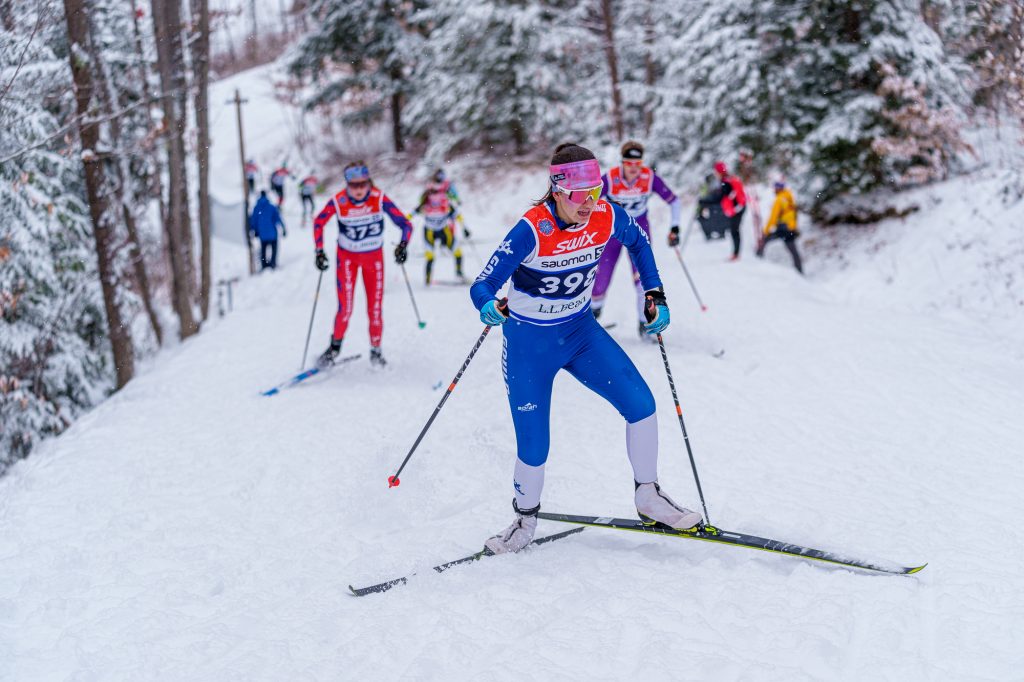by Adam Terko
Cross country skiing is a sport of fluid movement and speed. But not everyone has to don Lycra and a race bib to get the most out of smooth skiing. Techniques and skills used by top racers can also benefit touring skiers and novice Nordic athletes alike. From climbing steep pitches to setting up the best pair of skis for a day on snow, here are a few key approaches that you don’t need an FIS license to employ.

Master the classic herringbone
One of the most basic techniques learned in skiing is the herringbone, a movement where classic skis are staggered in a V-shape to climb a steep hill. The pattern left in the snow resembles the bones of a fish, hence the unique name. While using the herringbone is commonplace for novice skiers, top athletes also employ it when courses and conditions are too steep or slippery to allow for classic striding. Because of its universal applications, the herringbone should be practiced regularly by all types of skiers.
The width of the V-shape you make with your skis depends on the steepness of the hill. The greater the gradient, the wider the spread between ski tips. Don’t be afraid to change the angle of your skis as the angle of the hill changes.
Alternating opposite arm and leg, ascend the hill with a stepping motion, being careful not to let the skis glide (which is actually a skating motion). Keep your hands close to your body and avoid reaching too far up the hill, which could make you trip.
As you crest the top of the climb, narrow your skis gradually until your feet return to a parallel position and revert back to striding and gliding.
Learn to pole on both sides
Most people are primarily right- or left-handed in daily life—writing down notes, slurping soup with a spoon or kicking a soccer ball come naturally to one side or the other. Similarly, while climbing hills in the skate technique, a skier will feel more comfortable poling on one side than the other. But it helps to become ambidextrous.
On climbs, the most technically proficient athletes alternate between sides with their V1, poling on the same side as the first ski that comes into contact with the snow. If the grade of a climb tilts upward to the right, skiers will gain more ground by poling on the right and vice versa if a slope is angled to the left.
Recreational skiers can benefit from swapping sides too, as it helps cover more ground with each push. You’ll be able to reach the tops of hills sooner and waste less energy. But it can be tough to work on the weak side.
Start by counting internally (or out loud) and after eight or 10 strokes, switch your poling side from the right to the left. Make a quick tap of the poles on one side before a fast-timed swap to the other side. Do this regardless of the hill’s slope, or even on flatter terrain, to force a bit of muscle memory. Then seek out hills with different gradients to challenge your comfort zone.

Give your skis some TLC
While long nights in the wax cabin are usually reserved for World Cup technicians and service staff, well-prepared skis benefit anyone. Taking care of your equipment, even in small spurts now and then, can make a big difference in your enjoyment on snow.
A ski’s glide zones can easily get dirty. Use a dedicated glide-zone cleaner to keep skis moving well in all conditions; even just using a steel brush to sweep dirt and detritus out of the bases helps. You don’t need to do this every day but attend to it at least once every week or so.
If you use kickwax and klister on your skis, use a kickwax remover between waxings. It doesn’t take long for dirt to clog the sponge-like pores of a ski base, even when the snow may appear clean. For fishscale skis, use the same cleaner on the glide zones to keep dirt at bay and keep skis both kicking and gliding.
During the summer, keep your skis in good condition by applying a layer of glide wax and leaving it unscraped. Store your gear in a cool, dry spot rather than in a humid attic or barn.
When it comes to skiing technique and ski care, professional athletes aren’t the only ones who benefit from taking a few extra steps. With the right approach and practices, everyone can get a little more from every day on snow.
This story first appeared in the Late Winter 2022 issue of Cross Country Skier (#41.2).